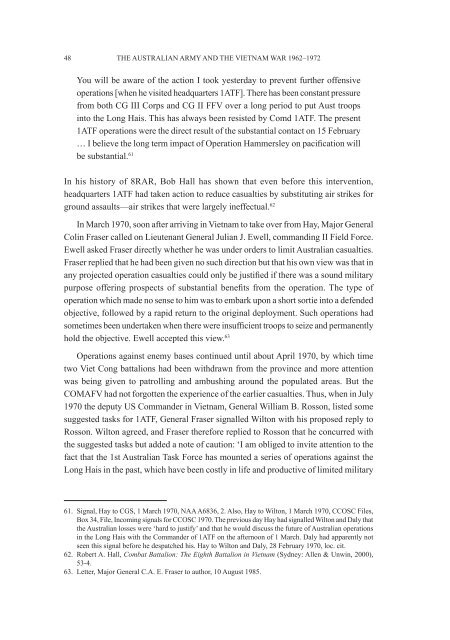conference proceedings - Australian Army
conference proceedings - Australian Army
conference proceedings - Australian Army
Create successful ePaper yourself
Turn your PDF publications into a flip-book with our unique Google optimized e-Paper software.
48<br />
THE AUSTRALIAN ARMY AND THE VIETNAM WAR 1962–1972<br />
you will be aware of the action I took yesterday to prevent further offensive<br />
operations [when he visited headquarters 1ATF]. There has been constant pressure<br />
from both CG III Corps and CG II FFV over a long period to put Aust troops<br />
into the Long Hais. This has always been resisted by Comd 1ATF. The present<br />
1ATF operations were the direct result of the substantial contact on 15 February<br />
… I believe the long term impact of Operation hammersley on pacification will<br />
be substantial. 61<br />
In his history of 8RAR, Bob hall has shown that even before this intervention,<br />
headquarters 1ATF had taken action to reduce casualties by substituting air strikes for<br />
ground assaults—air strikes that were largely ineffectual. 62<br />
In March 1970, soon after arriving in Vietnam to take over from Hay, Major General<br />
Colin Fraser called on Lieutenant General Julian J. Ewell, commanding II Field Force.<br />
Ewell asked Fraser directly whether he was under orders to limit <strong>Australian</strong> casualties.<br />
Fraser replied that he had been given no such direction but that his own view was that in<br />
any projected operation casualties could only be justified if there was a sound military<br />
purpose offering prospects of substantial benefits from the operation. The type of<br />
operation which made no sense to him was to embark upon a short sortie into a defended<br />
objective, followed by a rapid return to the original deployment. Such operations had<br />
sometimes been undertaken when there were insufficient troops to seize and permanently<br />
hold the objective. Ewell accepted this view. 63<br />
Operations against enemy bases continued until about April 1970, by which time<br />
two Viet Cong battalions had been withdrawn from the province and more attention<br />
was being given to patrolling and ambushing around the populated areas. But the<br />
COMAFV had not forgotten the experience of the earlier casualties. Thus, when in July<br />
1970 the deputy US Commander in Vietnam, General William B. Rosson, listed some<br />
suggested tasks for 1ATF, General Fraser signalled Wilton with his proposed reply to<br />
Rosson. Wilton agreed, and Fraser therefore replied to Rosson that he concurred with<br />
the suggested tasks but added a note of caution: ‘I am obliged to invite attention to the<br />
fact that the 1st <strong>Australian</strong> Task Force has mounted a series of operations against the<br />
Long Hais in the past, which have been costly in life and productive of limited military<br />
61. Signal, Hay to CGS, 1 March 1970, NAA A6836, 2. Also, Hay to Wilton, 1 March 1970, CCOSC Files,<br />
Box 34, File, Incoming signals for CCOSC 1970. The previous day Hay had signalled Wilton and Daly that<br />
the <strong>Australian</strong> losses were ‘hard to justify’ and that he would discuss the future of <strong>Australian</strong> operations<br />
in the Long Hais with the Commander of 1ATF on the afternoon of 1 March. Daly had apparently not<br />
seen this signal before he despatched his. Hay to Wilton and Daly, 28 February 1970, loc. cit.<br />
62. Robert A. hall, Combat Battalion: The Eighth Battalion in Vietnam (Sydney: Allen & Unwin, 2000),<br />
53-4.<br />
63. Letter, Major General C.A. E. Fraser to author, 10 August 1985.

















